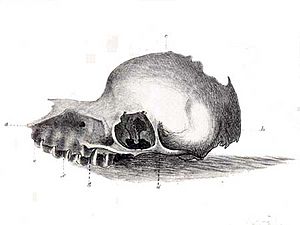Bunyip facts for kids
| Bunyip | |
|---|---|
Quick facts for kids  |
|
| Drawing of the legendary bunyip by_C.D._Richardson | |
| Creature | |
| Name: | Bunyip |
| Data | |
| Mythology: | Aboriginal Australian |
| First reported: | early 1800s |
| Country: | Australia |
| Habitat: | Swamps |
| Status: | Not proven real |
The bunyip is a mysterious creature from Aboriginal Australian stories. It's said to live in different water places like swamps, billabongs (which are like waterholes), creeks, and rivers. Many Aboriginal groups across Australia have stories about the bunyip, but they call it by different names. For example, some call it kianpraty or wowee. The name bunyip comes from the Wemba-Wemba language and often means "devil" or "evil spirit".
When Europeans first settled in Australia, many thought the bunyip might be a real, undiscovered animal. People reported seeing bunyips often in the 1840s and 1850s, especially in Victoria, New South Wales, and South Australia. Settlers wrote many stories about bunyips. These stories were often told to children to warn them to stay away from dangerous water areas.
What Does a Bunyip Look Like?
There are many different ideas about what the bunyip looks like. Early newspaper reports from the 1800s often described it with dark fur, a face like a dog, and sharp teeth and claws. Some said it had flippers, tusks or horns, or even a duck-like bill.
One writer, Robert Brough Smyth, collected many descriptions of the bunyip. But he found that most people didn't really know much about its looks or how it behaved. He thought they were too scared of the creature to notice its appearance properly.
Some experts think the bunyip stories might have come from a time when huge animals, called megafauna, lived in Australia. They compare the bunyip to extinct marsupials like the Diprotodon (a giant wombat-like animal) or the Thylacoleo. Other experts believe that people might have found the fossils (old bones) of these huge animals and thought they were bunyip remains.
Early Stories from Settlers
The first time the bunyip was written about by Europeans was in July 1845. A newspaper reported that some fossils were found near Geelong. When these bones were shown to an Aboriginal man, he supposedly recognized them as belonging to a bunyip. He was asked to draw a picture of it.
The newspaper described the bunyip as having a head like an emu and the body and legs of an alligator. Its legs were said to be strong, with short, thick back legs and long front legs. It also had long claws. In the water, it swam like a frog, but on land, it walked on its back legs and stood about 12 or 13 feet (3.7 or 4.0 m) tall.
In January 1846, a strange-looking skull was found near the Murrumbidgee River in New South Wales. The person who found it said that all the local Aboriginal people he showed it to called it a bunyip. This skull was put on display at the Australian Museum in Sydney. Many people came to see it, and The Sydney Morning Herald newspaper wrote that visitors shared their own "bunyip sightings."
Another early story about the bunyip was written in 1852 by William Buckley, an escaped convict. He wrote that in many lakes he visited, there lived an "amphibious animal" (meaning it could live on land and in water) that the Aboriginal people called Bunyip. He claimed he only ever saw the animal's back, which he said was covered in grey feathers. He described it as being the size of a small cow. Buckley also said that people believed the bunyip had supernatural powers.
Images for kids
-
An 1882 drawing of an Aboriginal man telling the bunyip story to two white children.
-
Illustration by H. J. Ford for "The Bunyip" tale in the Brown Fairy Book.
-
Bunyip as shown in Bibhutibhushan Bandyopadhyay's Chander Pahar. Art by Jukto Binir Basu.
See also
 In Spanish: Bunyip para niños
In Spanish: Bunyip para niños







